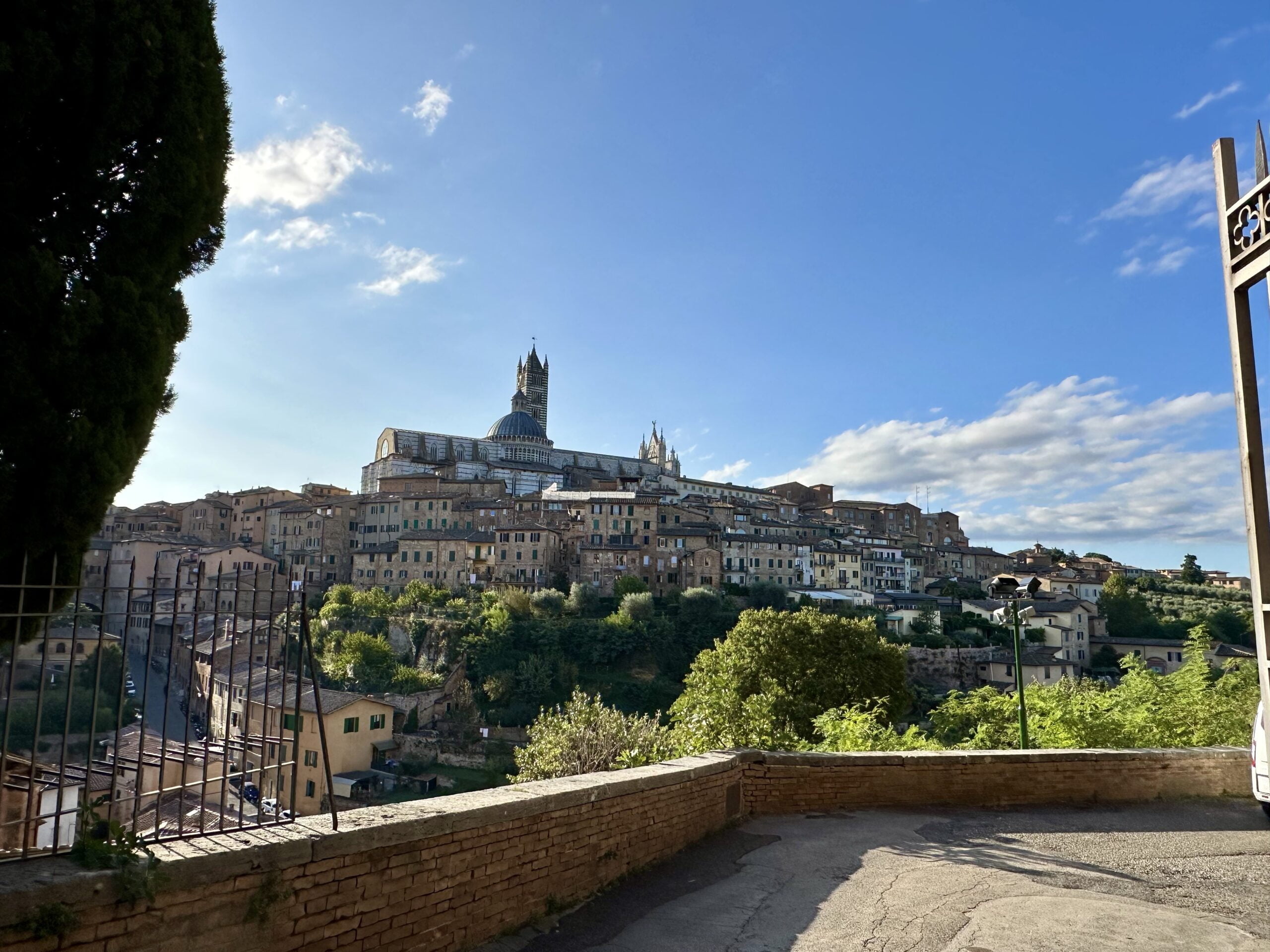Estimated reading time: 1 minute
Table of contents
- Siena is the Heart and Soul of Tuscany
- A Brief History of Siena
- Day 1 – Arrival in Siena
- Exploring Siena
- Navigating the Maze of Ancient Streets
- Our First Dinner In Siena
- Day 2 – Discovering Siena
- Piazza del Campo:
- Via Banchi Di Sopra
- Piazza Salimbeni
- Loggia del Papa
- Shopping for groceries – the Consorzio Agrario di Siena
- Dinner at Osteria Da Trombicce
- Day 3 – Il Duomo di Siena – the Siena Cathedral
- Dedicated to Santa Maria Assunta
- Santa Maria della Scala and Museo dell’Opera
- Facciatone
- Dinner at Pier Pettinaio
- Day 4 – Day Trip to San Gimignano
- Tenuta Torciano Wine Tasting Experience
- Day 5 – The Porta di Cielo
- Day 6 – Climbing the Torre del Mangia, Orto de’ Pecci Gardens
- The Orto de’ Pecci Gardens
- Day 7 – The Tuscan Countryside, San Quirico d’Orcia and Montepulciano
- Our Last Dinner in Siena
- Day 8 – Leaving for Florence
- Map of Siena Old Quarter
Siena is the Heart and Soul of Tuscany
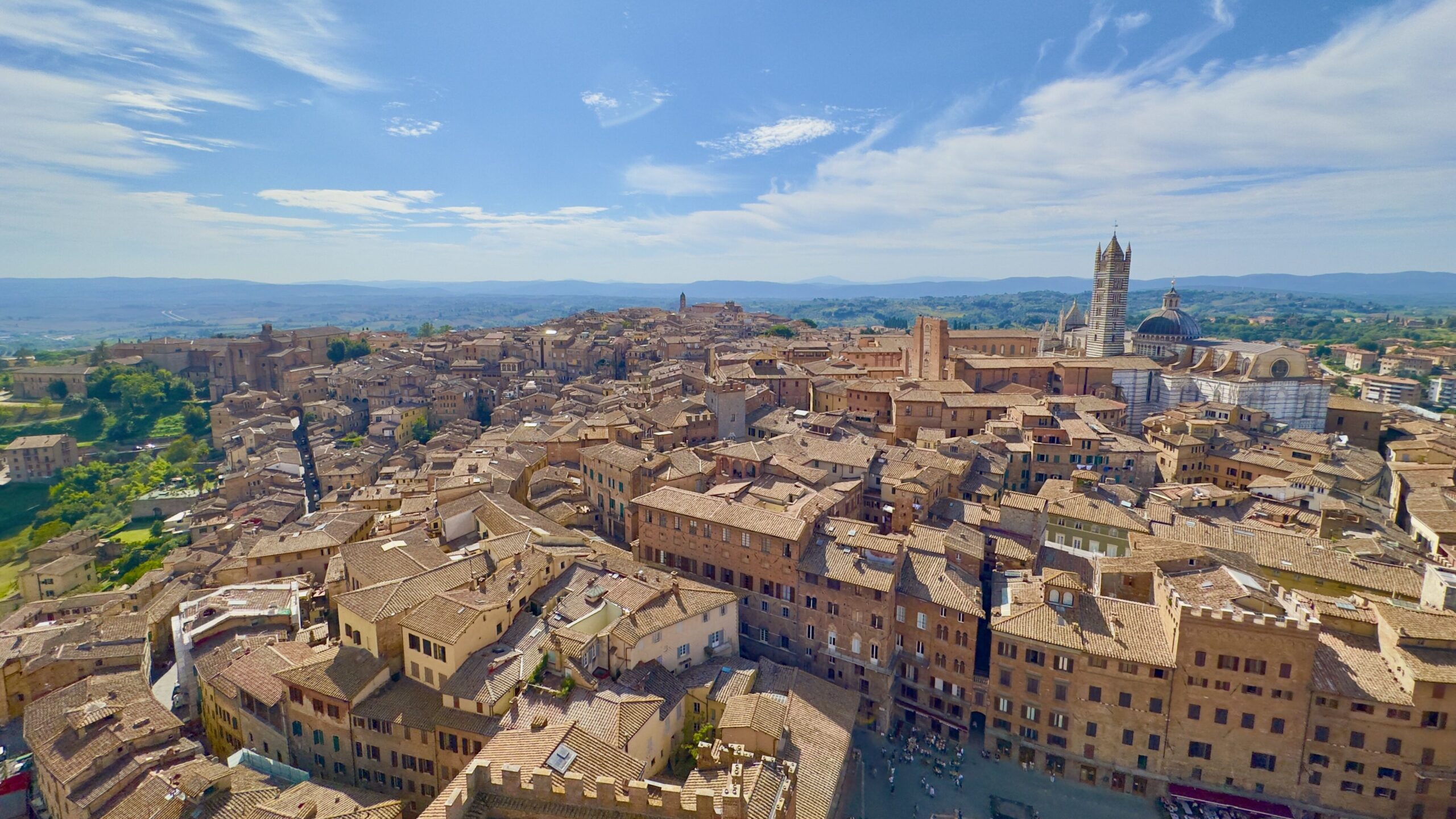
Imagine a hilltop town in the heart of Tuscany, surrounded by bountiful vineyards, olive groves and golden fields ready for the harvest. In every direction, dazzling vistas of lush green hills, cypress-tree lined roads and ancestral homes, some dating back millennia.
Behind its once impenetrable defensive walls, this fortress city whose origins date back to Antiquity offers cobblestone street, vast piazzas and stout stone buildings with their red tiles roofs that have withstood the test of time. That, in a nutshell is Siena Italy.

A Brief History of Siena
By far our most favourite destination in Italy, Siena is located in the very heart of Tuscany. It is the seventh largest city in in the region by population according to the 2023 census data. Yet until 1555, it was a fierce rival of Florence and vied for influence and prosperity in the region.
The city was in a constant state of war with its neighbour to the north. The war only ended when Florence allied itself with all powerful Spain and crushed the resistance to Florentine rule.
This long-standing power struggle between Siena and Florence is one of the reasons why Siena is as a fortress city. Its high walls and fortifications are still visible today. It’s location on the top of a tall hill gave Siena a strategic advantage for many years. And still give it a stately air of prominence as you approach from a distance.
Day 1 – Arrival in Siena
Our host met us at the Roman Gate. I eagerly flipped him the keys to our DS-7 which he eyed suspiciously and with a little apprehension. We would soon see why as he gingerly navigated the cobbled streets. We were heading to our rented apartment located less than 50 meters from the Piazza. Talk about centrally located!
The streets were narrow and steep. Pedestrians leisurely strolled in front of us, oblivious to the presence of our vehicle. Or maybe they just didn’t care. Service vehicles hugged the walls as we passed in the opposite direction, side mirrors retracted for extra care. Traveling at speeds of less than 20 km/h, it took a good 15 minutes to reach our main entrance. But who’s in a hurry, the day was still ahead of us.
Exploring Siena
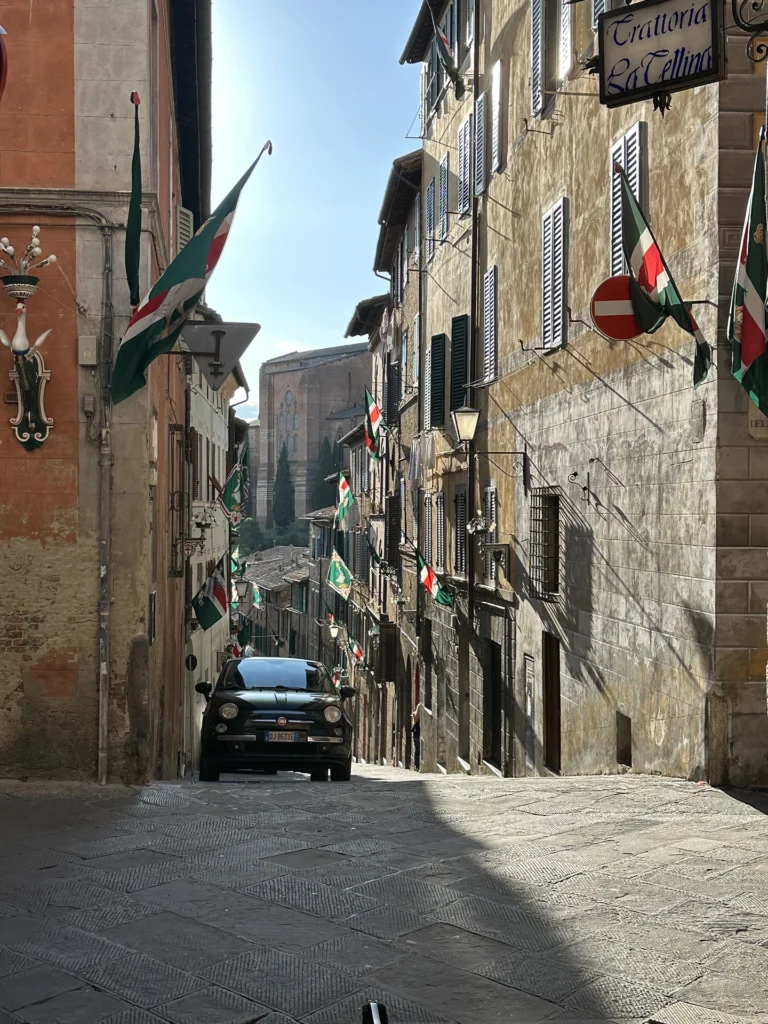
I love to walk. It’s the best way to discover a new destination. It gets you up close to the sights and the people in their day-to-day surroundings. So, camera and iPhone in hand, I set out to explore the streets of Siena.
Because of its ZTL (Restricted Traffic Zone), the Centro Storico or historic center is mostly pedestrian with limited local traffic. It’s an incredibly clean city and the air is wonderfully pure as well. Adding to the ambiance, each of the 17 contradas decorate their streets with their colourful flags. This creates a festive atmosphere throughout the year.
On some evenings, proud citizens take to the streets in a procession that winds through Siena, waving flags and beating drums. I read that this happens mainly on Sundays. However, while we were there, we saw or heard at least three processions making their way through the streets.
Navigating the Maze of Ancient Streets
Cobblestone streets dating back hundreds of years. They wind through the city, following the topographical profile of the hill on which Siena was originally built.
If you look at a terrain view of the town map, you’ll notice that the main streets in the old quarter follow the crest of the hill. The side streets drop off on either side.
This feature is shared by many hilltop towns in Tuscany. It’s part of their charm. But it also makes getting around a bit tougher. Sometimes, it feels more like a strenuous workout than a leisurely stroll. Plan your outings accordingly. A good pair of sensible shoes is usually a safe choice. High heels on cobblestone, not so much.
Mobility Pro Tip
If you have mobility issues, you’ll want to follow the terrain at the center of the old quarter. This we help you to avoid steep hills. When heading North from Piazza del Campo , it is best to take to the left on Banchi di Sotto which has a more gradual incline all the way up to Via delle Terme and Piazza Indepenza.
The street on the left, Costarella dei Barbieri, is quite steep and overly crowded. Walking with a cane or using a wheelchair is a bit more challenging.
Also, while there are a number of public parking space to the south of Piazza del Campo, near the farmers market and the soccer stadium, they are well below the level of the main parts of the historic center. Instead, there is a drop-off point at the top of Via Banchi Di Sopra with parking nearby. Access to the Centro from there is relatively “flat”.
Our First Dinner In Siena
Not having made a reservation for dinner on arrival in Siena proved to be a mistake. It was a busy Saturday and the city was teeming with visitors. We ended up in a sort of improvised outdoor restaurant near our apartment. Contrary to popular belief you can find a bad meal in Italy.
Foodie Pro Tip
Always book a table in advance, particularly on weekends. You can always make last minute changes if required. However, leaving things to chance can lead to unpleasant experiences like the one above.
Not sure where to eat? Play it safe and search popular review sites like Yelp and Google for the top restaurants. If you’re staying in an AirBnb, reach out to your host and ask for a recommendation. At a hotel? Write the Concierge whose job it is to make recommendations and arrange a table. And be sure to thank them appropriately if you enjoy the experience.
Day 2 – Discovering Siena
On our second day in Siena, we focused settling in to our apartment and getting to know our surroundings. We started with a walk in the Piazza del Campo, admiring the architectural beauty of our surroundings.
Piazza del Campo:
Piazza del Campo is the main public space in the historic center of Siena. It is renowned for its beauty and architectural integrity, and is considered one of Europe’s greatest medieval squares.



The shell-shaped piazza is surrounded by the Palazzo Pubblico, the Torre del Mangia, and various palazzi signorili. It is also the site of the Palio di Siena, a twice-a-year horse race. Not to mention the finish location of the annual road cycling race Strade Bianche.
The piazza was paved in 1349 in a fishbone pattern with red brick and travertine, dividing it into nine sections. These section symbolizing the rule of The Nine who laid out the Campo and governed Siena.
The Palio of Siena
Siena is famous, among other things for a yearly equestrian competition know as the Palio. This horse race is a competition between the cities 17 Contrada that attracts thousands of tourist from around the world. The event takes place in June so we missed it but promised ourselves that we would return.
Fun fact
In the Bond film Quantum of Solace, there is a chase scene that takes place during the Palio. The scene takes viewers to the tilled roofs of Siena as Bond chases his adversary. Those who know the city will notice that the chase sequence shows a mishmash of locations from throughout the city. These are all stiched together together to create a thrilling scene. At one point, Bond appears to running towards the Piazza del Campo where the Palio takes place. The storyline suggests that he should be running away from it.
Fonte Gaia Fountain
Gracing the Piazza del Campo, opposite the Palazzo Publico is the exquisite Fonte Gaia (Joyous Fountain). It was created by Renaissance sculptor Jocopo della Quercia and completed in 1419 on the site of a spring that was fed by a network of underground tunnels known as “bottini”.

It was replaced with a Carrara marble replica in the mid 19th century. The original fountain was relocated to the Museum Complex of Santa Maria della Scalla where it remains to this day. The fountain is decorated with various frescos including the Madonna and child. Also prominently featured are a series of wolves. These symbolize the foundation of Siena by Senio, son of Remus (who as killed by his twin brother Romulus). The Sienese She-Wolf is prominently depicted throughout the city. More on that later.
Torre del Mangia and Palazzo Pubblico
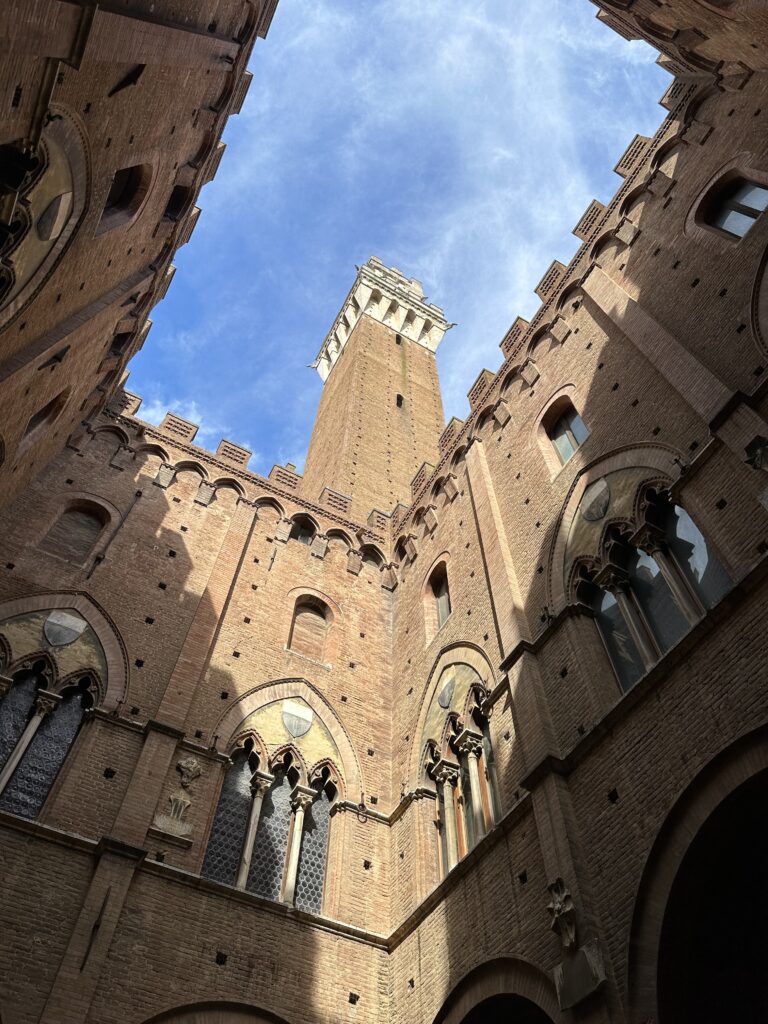
One of the main features of the Piazza is the Palazzo Pubblico. It is a gothic-style town hall building and features a clock tower and belfry, the Torre del Mangia. This stone tower stands 87 meters high and was built from 1325 to 1348.
It is the third tallest in Italy. You can’t help but marvel at the monumental task of building such a structure in the 14th century with only simple tools and techniques.
There are 400 steps to the top of the belfry. I attempted to reach the top in order to get a birds eye view of Siena and surroundings.
Needless to say I was totally out of breath when I reached the top of the narrow staircase. The staircase is so narrow in fact that you can touch both walls with barely outstretched arms. This came in handy as the steps are worn, narrow and quite steep.
As you reach the top, the horizon opens up before you, displaying an ocean of green and ochre. You can see for miles with the red clay roofs at your feet. Beyond the fortification walls, the Tuscan countryside spreads out in every direction. The view is magnificent and well worth the effort! You get a bird-eye view of the Duomo and all the major buildings that surround the Piazza.

Fun Fact: Who was “Mangia”?
According to legend the tower takes its name from the first bell ringer. He was a certain Giovanni di Balduccio, nicknamed “Mangiaguadagni”. This came from his habit of “eating through his earnings”.
I guess that anyone who climbs 400 steps every hour to ring the bell would work up a hearty appetite. Was he perhaps the original Foodie?
Connected to the tower is the Palazzo Pubblico, the civic palace, built between 1297 and 1310. It houses the Civic Museum that many exquisite works of art including sculptures and frescoed ceilings by Domenico Beccafumi.
Museo Civico – the Civic Museum
Inside the Palazzo Pubblico is the Civic Museum or Museo Civico. The Museo houses some of the most important frescoes and artworks from the Sienese School.
The museum’s collection includes masterpieces such as the “Allegory of Good and Bad Government” by Ambrogio Lorenzetti. This is a series of frescoes that depict the effects of good and bad governance on the city and countryside.






The museum also houses other important works, including Simone Martini’s “Maestà” completed in 1315, and Duccio di Buoninsegna’s “Guidoriccio da Fogliano.” The Palazzo Pubblico itself is a work of art, with its distinctive Gothic architecture.
While in the Civic Museum, I had the opportunity to explore the various rooms of the Palazzo. Each was adorned with frescoes and paintings that reflect the rich history and culture of Siena.
There is also a collection of sculptures, ceramics, and artifacts. The museum provides insight into the political, social, and artistic developments of the city during the Middle Ages and Renaissance.

Via Banchi Di Sopra
Via Banchi di Sopra is the main shopping street in the Siena old quarter. It starts in the north end of the city at Piazza Giacomo Matteotti where the buses drop off visitors taking tours of Siena.
The street then weaves its way through the old quarter in the direction of Piazza del Campo. Lined on either side with quaint boutiques and local shops offering all kinds of merchandise, interspersed with the usual list of big names in fashion.
There are pastry shops and bakeries, restaurants and bars. You’ll find everything you need to make your stay memorable.
One stop that I particularly appreciated was the menswear shop called Spada Roma. It’s a small chain of store in Italy but it has a local boutique vibe to it. I purchased a couple of scarves which I wore to dinner on a few chilly evenings.
Also be sure to check out the Grom Gelateria that offers a selection of vegan, gluten-free and lactose-free items.
Piazza Salimbeni
At the top of Via Banchi di Sopra, you’ll find a small piazza. At its center the sculpture of a priest. The Gothic-style palace at the back is known as Palazzo Salimbeni. It is the site of one of the oldest banking houses in Europe, the Banca Monte dei Paschi di Siena.
In the center of the square is the statue of Sallustio Bandini, a Sienese priest and one of the first Italian economists. It was sculpted by Tito Sarrocchi in 1882.
Loggia del Papa

The Loggia del Papa is a 15th-century Renaissance open-air arcade located in the Piazza del Papa in Siena, Italy.
It was built by Pope Pius II in honor of his family, the Piccolomini. It is considered a symbol of papal power and influence. The Piccolomini name comes up repeatedly throughout Siena including in the Duomo. Both Pius II and Pius II were Piccolomini.
The loggia features majestic Renaissance-style arches and a frieze that reads “Gentilibus suis Picolomineis” (Family of Piccolomini).
Shopping for groceries – the Consorzio Agrario di Siena
But above all, my favorite place was the Cosorzio Agrario di Siena, the Siena Agricultural Consortium. It is located on Via Pianigiani at the corner of Costa Incrociata. This shop features a dizzying selection of fresh produce, salumi, bread and baked goods, fresh pasta, olive oil, cheese and, of course, wine. Everything is produced locally by Cosorzio members.

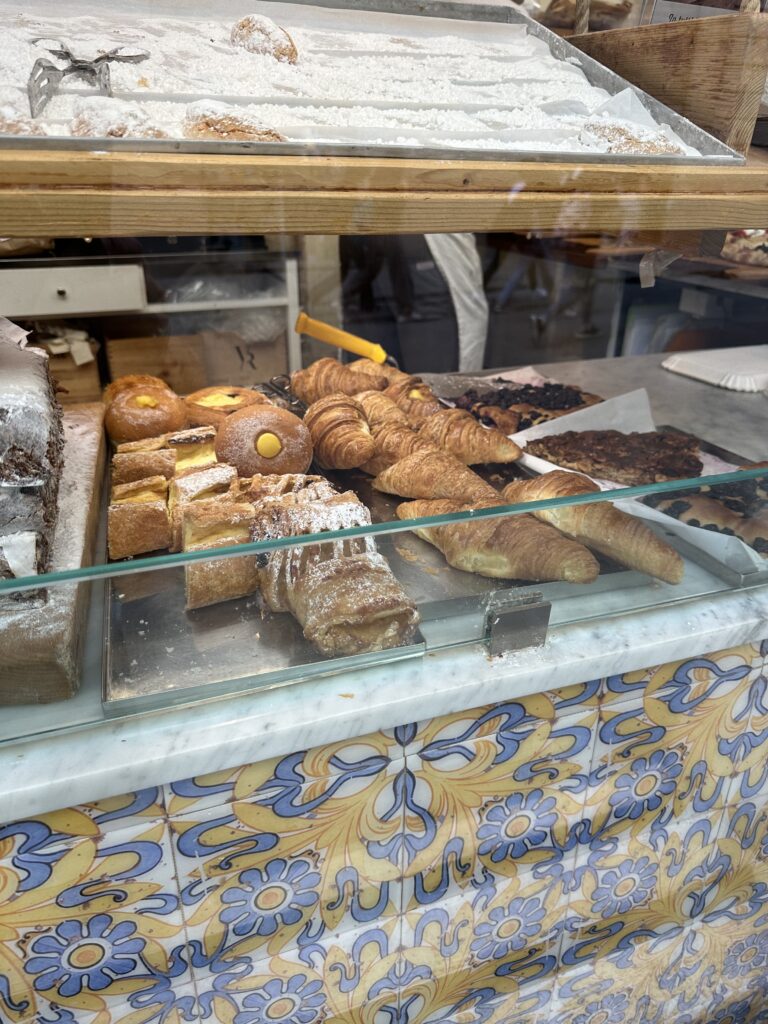
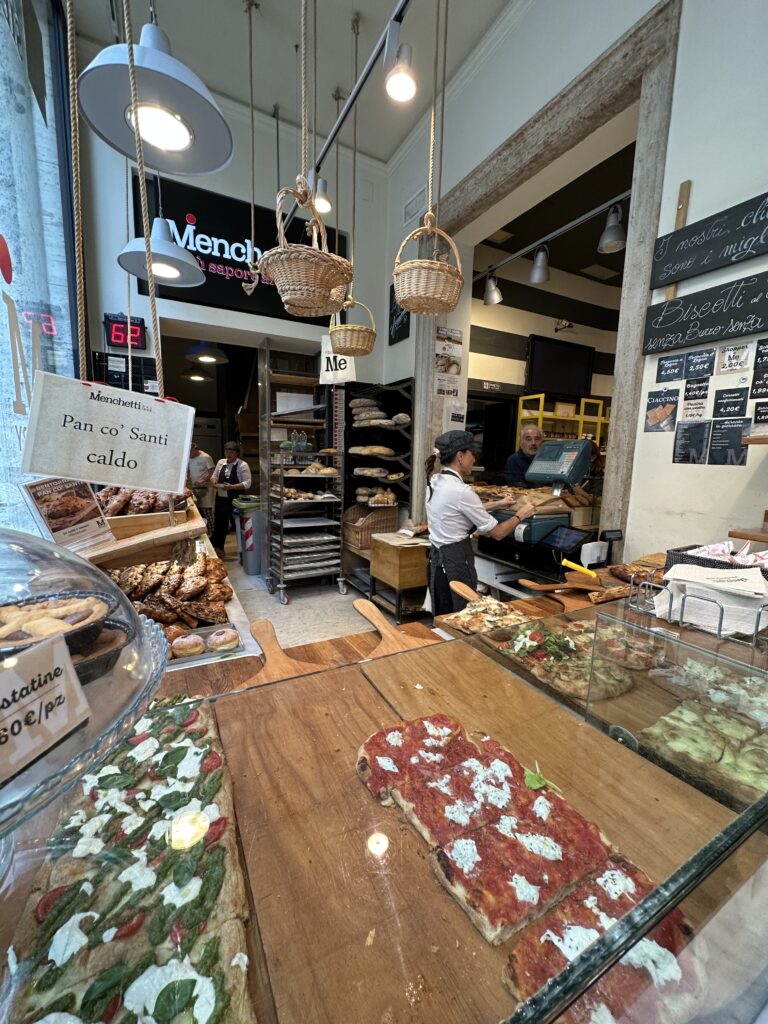
Dinner at Osteria Da Trombicce
Osteria Da Trombicce is known for its inventive and delicious food, offering a unique experience for both tourists and locals. The restaurant is praised for its wonderful and fresh menu, including dishes like tartare and homemade tagliatelle al ragù.
Day 3 – Il Duomo di Siena – the Siena Cathedral
Now that we were acclimatized to the layout of the city, we wanted to take a deep dive into one of the most impressive attractions to be found in Siena: The Duomo di Siena or Siena Cathedral.
This impressive structure and the other buildings that surround the Cathedral requires more than one day of visiting. This is particularly true if you want to also enjoy some time outdoor soaking up the Tuscan Sun.
Dedicated to Santa Maria Assunta
Il Duomo di Siena is also known as the Cathedral of Santa Maria Assunta. It is one of the most distinctive of Romanesque and Gothic cathedrals in Italy. It is perched atop the highest point in Siena. Its proud black and white structure dominates the Sienese landscape and the Tuscan countryside as you approach the city.
This is the most significant landmark in Siena and well with a visit. Its art collection is exquisite and the architecture and design are amazing. I purchased the Porta di Cielo tour in addition to the basic ticket and found it was well worth the few extra Euros.
Only drawback is that it is so popular that you need to book a time in advance. I returned later to get the full tour experience. And it was worth the wait.

These are just a few highlights of our visit to the Duomo. You can read a detailed account of Duomo experience in this detailed post
Black and white marble walls



Inlaid marble floors
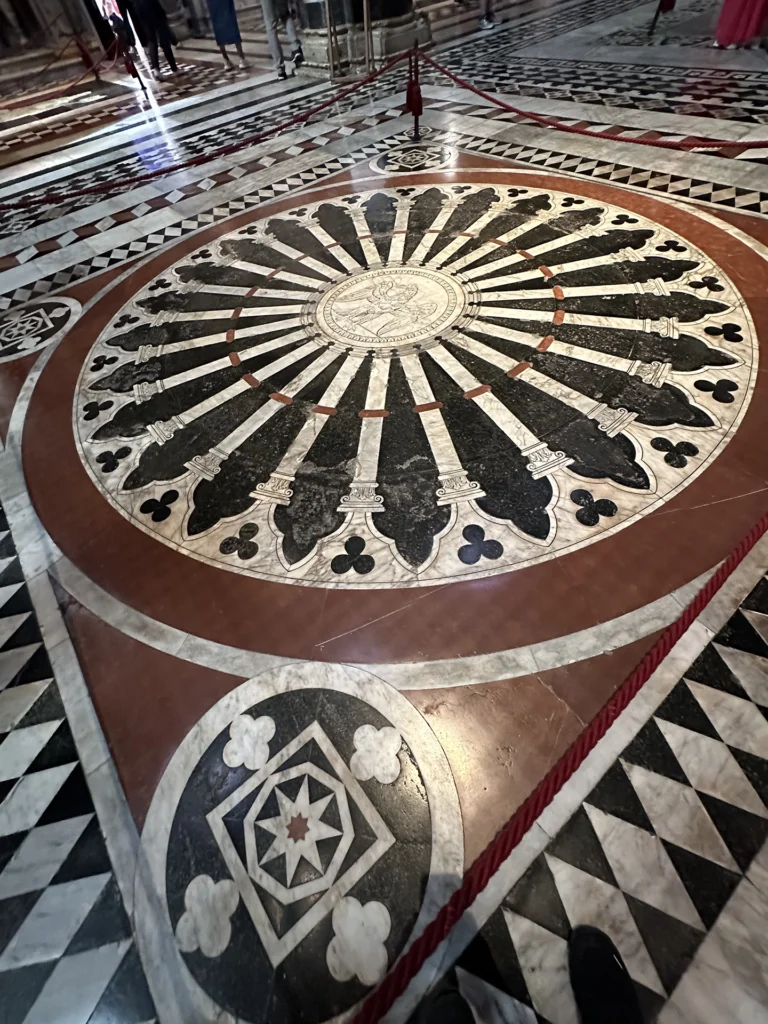


Detailed Stonework on the facade



Santa Maria della Scala and Museo dell’Opera
Found directly opposite the Duomo di Siena, Santa Maria della Scala Santa. Established in the 11th century, it was one of Europe’s first hospitals. It was dedicated to caring for abandoned children, the poor, the sick, and pilgrims. The complex now houses Museo dell’Opera. It contains works of art and architectural fragments that were formerly in, or a part of, the Duomo of Siena.
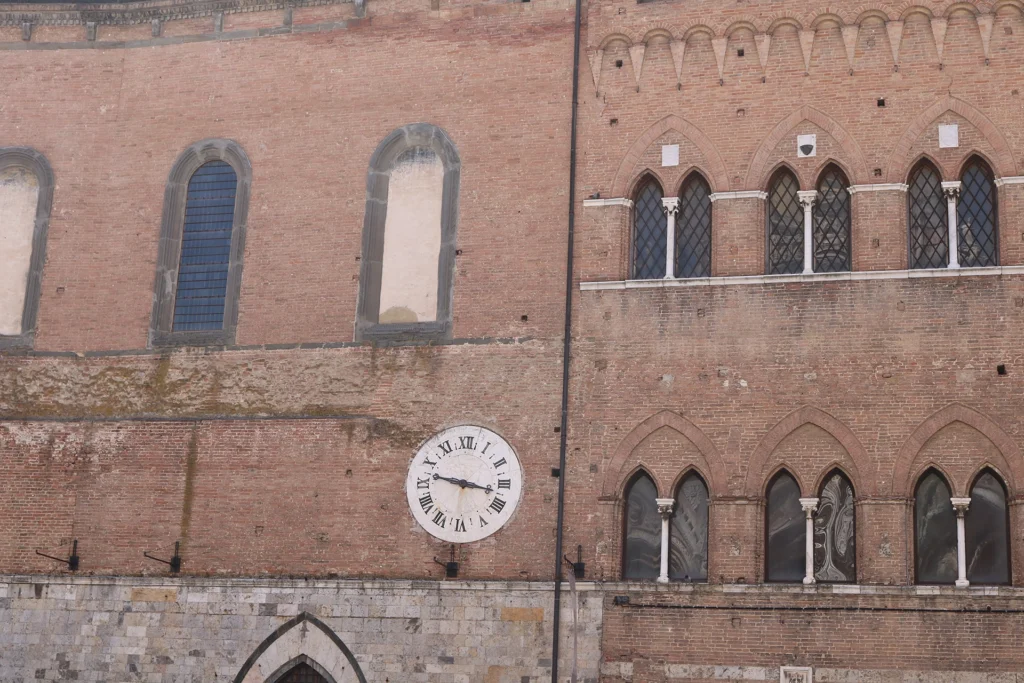


These include a number of Italian Gothic sculptures by Giovanni Pisano and his school from the façade of the cathedral, the Maestà of Duccio di Boninsegna, and works by Ambrogio and Pietro Lorenzetti. The museum is located within the Santa Maria della Scala complex and is one of the oldest private museums in Italy, founded in 1869.
Facciatone


The Facciatone is the remaining vestige of the planned expansion of the Duomo, which would have doubled in size as a result. The wall can be scaled for a panoramic view of the Tuscan countryside and access can be purchased with the OPA SI Pass. It’s an exhilarating climb if you’re not afraid of heights.
Dinner at Pier Pettinaio
Steps away from the Piazza del Campo, Ristorante Pier Pettinaio is located in a small alley of the same name just off one of the main shopping streets. A small terrasse with a half dozen tables sits outside, adding to the ambiance and charm. Due to the unseasonably warm weather for the last week of September, it was packed so we sat at a table inside.
Day 4 – Day Trip to San Gimignano
The beauty of Siena is that is stands at the heart of Tuscany with all the main villages and small towns within an hour’s drive. We initially had planned to spend more time on the road, exploring the Tuscan countryside but were having so much fun in Siena, that we limited our outings.
On day 4 of our week in Siena, we took the train from Siena to San Gimignano, a small walled medieval hill town in Tuscany. The train took us from Trenitalia station in Siena to Poggibonsi San Gimignano is under 30 minutes. The price of a second-class ticket: 3.90 Euros.
Efficient Public Transit to San Gimignano
The train was comfortable, modern and clean. The signage in the station was easy to follow. Though I love to drive, this was clearly a no-brainer. This was particularly true since the afternoon was dedicated to a winery tour and tasting at Tenuta Torciano.


From the train station, we caught a regional bus to the village of San Gimignano, known for its many medieval tower. San Gimignano is most impressive when observed from afar as it sits atop a hill.
This gives you a full view of the towers and fortifications, which are more difficult to observe as a whole from inside the city. Though far from comfortable, the bus ride got us there within a few minutes.
A Little History of San Gimignano
San Gimignano, according to legend was founded in 63 BC by two brothers – Muzio and Silvio – though not twins and no mention of black and white horses or wolves…The first documented mention was in the year 929. It became an important waypoint for pilgrims traveling to and from Rome .






San Gimignano is best known for its many distinctive tower houses. Of the 72 originally built, 14 still remain to this day and are a unique architectural feature of the town. Its Centro Storico is also a UNESCO World Heritage Site.
We entered through the Porta San Giovani and slowly walked up the ancient streets that lead to the public square, the Piazza della Cisterna. The piazza takes its name from the large ancient cistern that is found at its center and was the primary source of water for the villagers. An octagonal travertine well forms a pivot point in the triangular paved piazza.
Tenuta Torciano Wine Tasting Experience
After lunch our driver picked us up at Porta San Giovani and drove us through the Tuscan countryside to the Torciano property about 20 minutes away. We had booked the Wine tasting a grape stomping experience for a taste of what life was like in the vineyards was like a few decades ago during the vendemia or harvest.






Day 5 – The Porta di Cielo
Because one day is not enough, we returned to the Duomo on day 5 to complete the Porta di Cielo (heaven’s gate) tour which we had pre-booked earlier in the week. Around 11 am, we made our way to the meeting point inside the Cathedral, taking a few additional images of the grandiose interior.
From there our small group of about a dozen visitors made our way to a narrow staircase that took us to the roof of the cathedral. It’s a fairly easy climb, though tougher is you have mobility issues.
The Cathedral from On High



The tour took us through the attic of the Cathedral, allowing us to admire the hidden structure of the ceiling, get a glimpse of some of the tools used in the construction and even venture outside for a birds eye view of the surroundings. The nearby San Domenico Basicila and the Facciatone were in full view. In the distance the Tuscan countryside extends for miles and is absolutely breathtaking.
The highpoint of the tour is the view of the cathedral floor from above. You can see the full view of the beautiful inlaid floors, the vaulted ceilings as well as the stained-glass windows from up close. It is definitely worth the visit. See our detailed post on the Duomo di Siena for additional information and images.
Dinner at Osteria le Logge
Day 6 – Climbing the Torre del Mangia, Orto de’ Pecci Gardens
Siena is charming at street level, with its paved streets, historic buildings and friendly welcoming people. But to really appreciate the full beauty of this medieval city, you really need a bird’s eye view. And that’s exactly what you’ll find atop the Torre del Mangia tower that dominates the Piazza del Campo.
For 20 Euros, you get to walk up the 400 steps, worn by centuries of foot traffic, and reach the highest vantage point in Siena. At the top of the steep and narrow stairs is the belfry and an expansive view of the rooftops, major landmarks and the Tuscan countryside unfolding at your feet. The experience is well worth the effort.






The steps are so narrow that visitors must climb in groups at an assigned time to avoid crossing paths with descending visitors. You go up as a group and descend when you’re ready. The view from the observation deck at the top of the tower is breathtaking. Sight after sight enfolds in every direction.
From this vantage point, you can clearly see the ancient fortifications in the distance, as well as all the major landmarks including the Duomo and the Basilica San Domenico. You can also see the curving semi-circular layout of the streets below. You can also see Siena’s green spaces stretch out in every direction.
The Orto de’ Pecci Gardens
After descending from the Torre del Mangia, I made my way to the beautiful orchards I’d seen in the distance, the Orto de’ Pecci.
Siena’s old quarter is essentially one big mass of cobblestone streets, piazzas and alleys. Green spaces are rare in the Centro, but abound outside the city walls. For those want a quick dash of green, there’s nothing quite like the Orto de’ Pecci gardens in the heart of Siena.
It is easily accessible from the Piazza del Campo by way of via Porta Giustizia. According to sources, it takes its name from the fact that condemned prisoners used to be walked down this road on their way the gallows.
I was struck by the beauty of the olive orchards, arboretum and various gardens. The gardens are also connected to the Siena Botanical gardens, though I didn’t make it that far. It was a breath of fresh air and a unique point of view from which to admire the fortified City.



Fun Fact
Apparently, this whole area was inhabited in the 14th century until the Plague of 1348 swept through the city and wiped out a between 60 and 80% of the population. The exact percentage is varies from source to source.The homes were abandoned, fell into disrepair and were ultimately torn down to make way for the gardens which now contain a reconstruction of an old medieval orchard.
Dinner at Pier Pettinaio
Steps away from the Piazza del Campo, Ristorante Pier Pettinaio is located in a small alley of the same name just off one of the main shopping streets. A small terrasse with a half dozen tables sits outside, adding to the ambiance and charm. Due to the unseasonably warm weather for the last week of September, it was packed so we sat at a table inside.
Read about our dinner experience at Pier Pettinaio here
Day 7 – The Tuscan Countryside, San Quirico d’Orcia and Montepulciano
A road trip in Italy would not be complete without a leisurely drive through the Tuscan countryside (or two). By day 6 in Siena, we were ready to hit the road and take in some of the sights. A visit to Tuscany would be incomplete without a drive to Val d’Orcia and the little hilltop town of San Quirico. This beautiful region is famous for the picture-perfect Cypress-line roads that wind through the countryside.

So, we set off in search of the famous road and iconic home that stands at the end. Relying on Google, we found ourselves on a bumpy dirt road that snaked it’s way through the fields and vineyards. Only the find the road blocked by cables, concrete blocks and a rather large bulldozer. I guess we were not alone searching for the iconic scene and the local farmers said “enough!” On our way back we crossed paths with a half dozen travelers who like us were searching for the “Il Famosi Cipressi”.

San Quirico d’Orcia
Slightly disappointed but nonetheless thrilled with our excursion through the beautiful surroundings, we made our way to San Quirico d’Orcia. San Quirico is a small, charming, historic medieval village located in the Valdorcia region. It is perched on top of a hill and is known for its picturesque landscape, ancient streets, and medieval architecture.



The village is home to several notable churches. It is also famous for its beautiful gardens known as ‘Horti Leonini’, which date back to 1581 and are an example of Italian style gardens.
The village is easily accessible by car, and parking is available just outside the walls. It’s a short walk to the historic center.
The main street is lined with small boutiques and quaint cafés and restaurants. Just be mindful of the opening times as some close immediately after lunch for a couple of hours.
The Horti Leonini Gardens






The main attraction for us was the ‘Horti Leonini’ Gardens, with the neatly tailored hedges and shrubs. The Horti Leonini features a layout typical of a classic Italian garden.
It includes symmetrical allées, terraces, and collected sculptures, all of which are characteristic of an Italian Renaissance design. Some of the sculptures in the garden are classical while others, from the Forme nel Verde collection are almost futuristic creating an eclectic ensemble.
The garden’s central lane leads to a stairway that connects it to the upper area, which consists of a wood of centuries-old holm-oaks around a grassy space. The stairs are quite steep and uneven. Danielle decided to stay at the bottom as I explored the upper reaches of the garden.
Lunch in San Quirico d’Orcia
Leaving the Leonini behind, we found a garden terrasse located at the back of a wine shop and dined on Bruschetta, salumi and local cheeses. The meal was accompanied with a glass of local Vernaccia, a refreshing white wine that had become a staple on our road trip.



The wine store contained an impressive selection of local wines including Brunello, Rosso di Montalcino, various Super Tuscans, and some exquisite Chiantis.
And speaking of Brunello di Montalcino wine, for our next stop we headed fourteen km west to another hilltop town: Montalcino.
Montalcino
Montalcino is a beautiful medieval hilltop town southern Tuscany. It is renowned for the production of its precious Brunello red wine, one of the world’s best and most appreciated Italian wines. The town is dominated by the mighty and imposing Rocca or fortress built in 1361, offering spectacular views of the surrounding countryside.



In addition to its wine, Montalcino is rich in artistic treasures, with notable landmarks such as the Palazzo dei Priori, the city’s town hall, and several churches and museums. The town’s historical center is a wonderful place to stroll around, featuring charming arts and crafts shops, cafes, restaurants, and wine bars.
We entered Montalcino from the parking facility on Via Pietro Strozzi at the crest of the hill to make movement easier for Danielle whose ankle was in bad shape by now. This gave us easy access to the Centro Storico and the amazing views of the valley at its feet.
A Town of Many Churches
We entered through an opening in the fortification wall that took us to around Piazza del Popolo upon which stands the Concattedrale del Santissimo Salvatore, also known as the Montalcino Cathedral. Like many Tuscan villages, there are many churches and Montacino is no exception.



Along Via Roma, you’ll also find the Santuario della Madonna des Soccorso. There is also the Church of San Francesco, the Chiesa di Sant’antonio, the Chiesa di Santa Croce, the Chiesa del Corpus Domini and the Chiesa di Sant’Egidio all within an area of a few square miles. My wife and I have a strict “one-church-per-day” rule but did spend some time outside the Cathedral which was closed at that time of day.
Our Last Dinner in Siena
To close off a wonderful week, we returned to Pier Pettinaio restaurant for an Iconic Tuscan meal: Bistecca Fiorentina. Apparently, Pier Pettinaio serves the best Bistecca in Siena. Since this was our first, I had no point of reference but would not be surprised if this were true.
The steak was a full three fingers thick and weighed 1.3 kilos. According to tradition, the steak is presented to you raw at the table before being expertly prepared by the chef. As is fitting with such a wonderful piece of meat, we chose a delicious Brunello to accompany the meal. It was exquisite.
Day 8 – Leaving for Florence
On the Saturday morning of our departure, we enjoyed one last meal of caffè e brioche from my favorite pastry shop on Piazza del Campo. We then packed our bags, loaded up with fond memories of what – to this day – is our most favorite city in Italy. Then it was off to the Tuscan Capital of Florence. It’s an easy drive. No more than 45 minutes or so.
